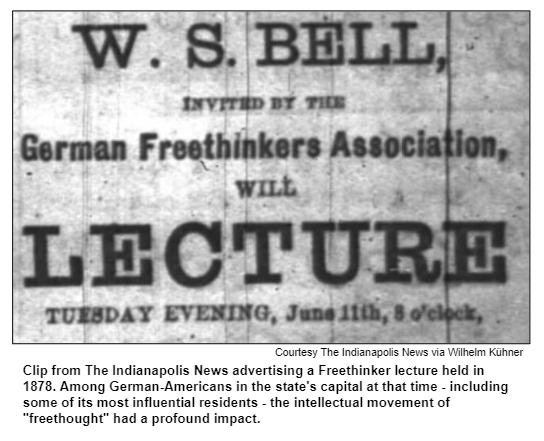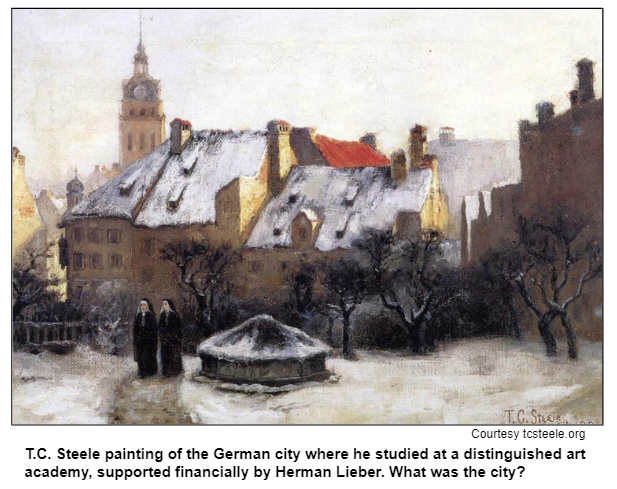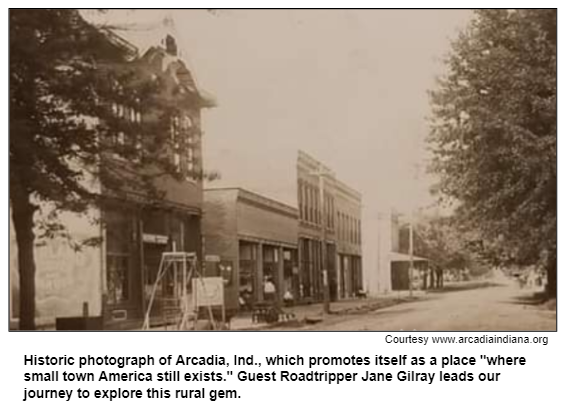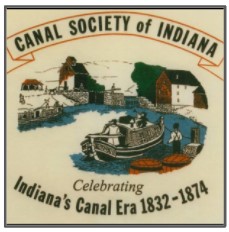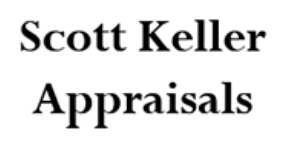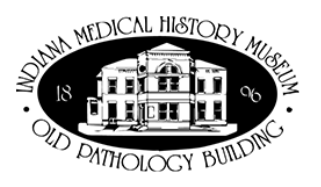Saturdays, noon to 1 p.m. ET on WICR 88.7 FM.
Or stream audio live from anywhere on WICR Online!
November 6, 2021
German freethinkers in Indy - Encore
During the 19th century, Germans became the largest European ethnic heritage group in Indiana. In 1870, immigrants and German-Americans in the state's capital - including some of its most influential residents - formed the Freethinker Society of Indianapolis.
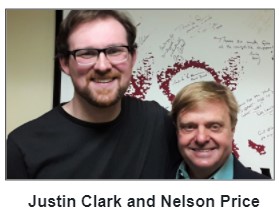 The immigrants, who included political refugees from a failed revolution in Germany in 1848, had a history in their homeland of "freethought.” Our guest on this encore broadcast of a 2019 show, public historian Justin Clark, described freethought as an "open evaluation of religion based on the use of reason." Justin is the digital initiatives director for the Indiana Historical Bureau, a division of the Indiana State Library. He was the communications director for the Indiana Archives and Records Administration when he was our guest and shared insights about the German freethinkers and their impact on their adopted hometown of Indianapolis.
The immigrants, who included political refugees from a failed revolution in Germany in 1848, had a history in their homeland of "freethought.” Our guest on this encore broadcast of a 2019 show, public historian Justin Clark, described freethought as an "open evaluation of religion based on the use of reason." Justin is the digital initiatives director for the Indiana Historical Bureau, a division of the Indiana State Library. He was the communications director for the Indiana Archives and Records Administration when he was our guest and shared insights about the German freethinkers and their impact on their adopted hometown of Indianapolis.
They included Clemens Vonnegut (1824-1906), the patriarch of a family that, for more than 110 years, owned an Indianapolis-based chain of hardware stores that he founded in the 1850s. Beginning in 1870, he served as the first president of the Freethinker Society of Indianapolis. During our show, Justin described how Clemens' freethinker beliefs influenced his great-grandson, literary icon Kurt Vonnegut Jr.
Other key figures in the Freethinker Society of Indianapolis included its co-founder, Herman Lieber, who immigrated from Germany in the 1850s and became the patriarch of an influential, multi-generational Indianapolis family. Lieber opened a small frame shop that became one of the most respected art dealerships of its era, employing more than 200 people.
According to Justin, the Freethinker Society was "one of the city's first non-religious organizations and facilitated freethought ideas and practices through educational lectures and social gatherings." At the society's events, these "philosophical radicals" discussed such topics as science, women's suffrage, socialism and theology.gy.

In a blog that Justin wrote for the Indiana Historical Bureau, he notes that, in Kurt Vonnegut's semi-autobiographical book Palm Sunday (1981), he describes his great-grandfather's freethinking as the novelist's own "ancestral religion."
Clemens Vonnegut, Herman Lieber and others in Indianapolis - as well as German Americans in other cities during the late 19th century - were influenced significantly by Karl Heinzen, a Boston-based freethinker. In 1882, Heinzen wrote Separation of Church and State, a widely distributed book. He traveled to Indiana several times and became a professional colleague of Lieber, according to Justin Clark.
All of them, in turn, were influenced by Robert Ingersoll (1833-1899), an orator known as the "great American agnostic."
In Indianapolis, the freethinkers established an industrial trade school and a secular Sunday school. But the Freethinkers Society of Indianapolis dissolved in 1890 because, among other reasons, the organization had "spread itself too thin," Justin Clark says. He emphasizes, though, that its impact endured, including in the literature of Kurt Vonnegut Jr.
History Mystery
In addition to being a co-founder of the German Freethinker Society of Indianapolis, Herman Lieber was an art patron. In the early 1880s, he raised the funds for his friend, painter T.C. Steele, to study at a distinguished art academy in a major city in Germany. T.C. Steele, who eventually became best-known for his paintings of Indiana landscapes, was joined at the German art academy by some of the other artists who later became famous as the Hoosier Group.
Question: What major German city was the location of the art academy where T.C. Steel studied?
As this is an encore presentation, do not call into the show.
Roadtrip: Arcadia in Hamilton County
Guest Roadtripper Janet Gilray of Legacy Keepers Music invites us on a jaunt to the delightful small town of Arcadia, located just a hop, skip and a jump up the road from her place in northern Hamilton County.
The sign just outside of Arcadia proclaims it to be "where small town America still exists," and the town certainly lives up to that assertion. There's not a single traffic light in Arcadia, Janet tells us, and its small-town pleasures include taking an old-fashioned stroll down Main Street, where 120-year-old brick storefronts convey the charm and friendliness of a bygone era.
Just a few blocks away is the Arcadia Depot, a long-time stop on the Nickel Plate Railroad. The Depot was built in 1869 and is now a small museum featuring story boards and an antique telegraph, where you can try your hand at Morse code. Other displays present WWI memorabilia and authentic Arcadia glass from the nearby D.C. Jenkins Glass Factory. In its heyday, Arcadia was home to glass and tin factories powered by the natural gas boom of the 1880s, and the Arcadia Depot is a part of this rich railroad history.
Be sure to join Janet as she shows off this small-town gem!
Hoosier History Live is serious about needing financial help
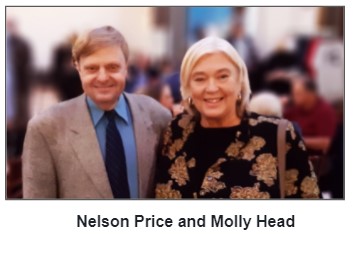 Hoosier History Live does not just simply "happen". Every month we have fixed costs to maintain, such as updating our website, keeping our newsletter current, creating our weekly podcasts, and maintaining social media. We enjoy creative freedom as an independently produced project. We think we have a media voice like no other.
Hoosier History Live does not just simply "happen". Every month we have fixed costs to maintain, such as updating our website, keeping our newsletter current, creating our weekly podcasts, and maintaining social media. We enjoy creative freedom as an independently produced project. We think we have a media voice like no other.
The thing about professionals is that we always make everything look so easy. Which is deceiving in that we really work very hard.
Would you like to help us finish out the year with our full features, such as weekly newsletter, podcasts, and social media? And would you also be okay with some of your funding going into preserving and distributing our show archives? We are proud of the work we do, weekly, monthly, and year after year. We are also committed to preserving our show archives and making sure all our podcasts are free to listen to and available to all. Molly Head will be leading this major project.
For individual contributions, just visit the yellow "donate" button on our e-newsletter or website. Prefer paper? Visit Support the show! For organizational sponsorship, which includes logos, links, and voiced credits in the show and in podcasts, email molly@hoosierhistorylive.org, or call or text (317) 506-7164.Nelson Price, host and historian
Molly Head, producer/general manager, (317) 506-7164
Ryan DeRome, associate producer
Cheryl Lamb, administrative manager
Richard Sullivan, senior tech consultant
Pam Fraizer, graphic designer
Garry Chilluffo, consultant
Please tell our sponsors that you appreciate their support!

 Acknowledgments to Monomedia, Visit Indy, WICR-FM, Fraizer Designs, Heritage Photo & Research Services, Henri Pensis, Aaron Duvall, Chloe Tyson, and many other individuals and organizations. We are independently produced and are self-supporting through organizational sponsorship and through individual contribution at the yellow button on our newsletter or website. For organizational sponsorship, which includes logos, links, and voiced credits in the show, contact Molly Head at (317) 927-9101 or email her at molly@hoosierhistorylive.org. Our media reach continues to grow via podcasting and iTunes.
Acknowledgments to Monomedia, Visit Indy, WICR-FM, Fraizer Designs, Heritage Photo & Research Services, Henri Pensis, Aaron Duvall, Chloe Tyson, and many other individuals and organizations. We are independently produced and are self-supporting through organizational sponsorship and through individual contribution at the yellow button on our newsletter or website. For organizational sponsorship, which includes logos, links, and voiced credits in the show, contact Molly Head at (317) 927-9101 or email her at molly@hoosierhistorylive.org. Our media reach continues to grow via podcasting and iTunes.
Thank you!
We'd like to thank the following recent, new and renewal contributors whose donations help make this show possible!
- David Yount
- Bob Levy and Kathy Alexander
- Madalyn Kinsey
- Charles Schisla
- Anonymous
- Greg Larson
- David and Theresa Berghoff
- Tom Swenson
- John Stanton
- Kathleen Angelone
- Melissa Martin
- Dr. William McNiece
- Michael Freeland and Sharon Butsch Freeland
- David E. and Lynne J. Steele
- Ann Frick
- Ryan Zumbahlen
- Tim and Meg Shelly
© 2021 Hoosier History Live. All rights reserved.
|

